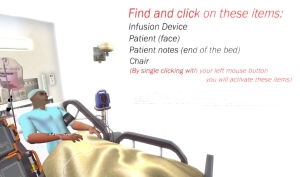
The Virtual Patient in an Interactive Clinical Scenario
In this project for NHS Training for Innovation the Department of Biosurgery and Surgical Technologies at Imperial College London designed, built and tested a scenario-based simulation in the 3D virtual world of Second Life. The project helped to validate the use of Second Life as a novel platform for medical device training in a simulated clinical environment. It enabled participants to learn and practice in a complex but safe environment where they could make mistakes, without risk to any real patients.
Visit the project in Second Life on ‘Medical School’
The island is public whenever possible but may be restricted when research is being conducted. Please contact Davee Commerce (SL) if you require access.
A major challenge in medical education continues to be the balancing of limited teaching resources with the delivery of engaging, student-orientated programmes that place patient safety as a central theme. In modern, time-pressured curricula there is often reduced clinical contact and limited ward-based teaching. In response to this and to important concerns over patient safety and the reduction of medical errors, leaders in medical education have developed a range of specialized simulation instruments that enable participants to develop their skills in key areas. The Department of Biosurgery and Surgical Technology at Imperial College London are world renowned for their work in this field.
In the first pilot of the scenario all of participants (who were nurses from a wide range of NHS specialities and mostly new to Second Life) stated that the scenario was useful for medical device clinical scenario training and 82% would recommend the scenario as training to nursing students and colleagues.
Scenarios such as this can present a more realistic training environment and enable the participant to see the consequences of their actions in a clinically safe environment that does not endanger the real patient, and can help reduce real life medical errors. There is significant potential for the development of this technology in medical education to improve existing training and quality of patient care.
You must be logged in to post a comment.